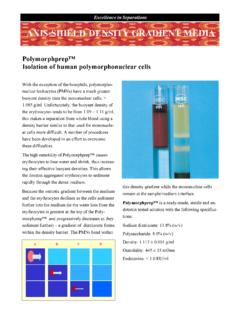Transcription of OptiPrep™ Preparation of gradient solutions
1 optiprep Preparation of gradient solutions Measurement and calculation of densities The density of optiprep solutions can be determined directly and accurately by weighing a known volume using a density bottle. Weighing a series of aliquots dispensed from an automatic pipette (calibrated with water) on an electronic balance is a permissible but less accurate alternative. However the most convenient way of determining the density is to measure the refractive index. Another method for determining the density of a solution is to measure its absorbance. If a solution of iodixanol of known density is mixed with a diluent (whose density is also known), the density of the mix-ture can be calculated from the following equation: D = Density of mixture; V = volume of iodixanol solu-tion; d = density of iodixanol solution; V1 = volume of diluent; d1 = density of diluent. optiprep working and gradient solutions for mammalian cells An illustrative example for preparing working solutions for cells, based on a cell suspension medium (CSM) con-taining (w/v) NaCl, 10 mM Tricine-NaOH, pH , is given in the Table 1 below.
2 Table 2 describes the densi-ty of gradient solutions prepared by dilution of the work-ing solution with CSM. Hepes-buffered media provide solutions of identical densities and refractive indices. The 40% iodixanol Working Solution contains 10 mM Tricine-NaOH, pH , hence dilutions of this solution with the CSM will contain the same buffer concentra-tion. If it was also necessary to maintain a low concentra-tion of another reagent ( 1 mM CaCl2) in the gradient , the optiprep diluent used to prepare the Working Solu-tion would also contain 3 mM CaCl2. Low concentrations of such additives will not significantly change the osmolali-ty of the gradient solutions . If it is not necessary to maintain a constant ionic and buffer composition in the gradient , isoosmotic solutions can be prepared simply by diluting optiprep with an isoosmotic salt medium. This diluent can be the standard buffered (w/v) NaCl or it can be a routine culture medium such as DMEM or RPMI.
3 All these media (in the absence of added serum) have densities of g/ml (Table 3). A cul-ture medium containing 10% serum has a slightly higher density at approx g/ml. Because most mammalian cells have densities below g/ml, a convenient Working Solution ( = g/ml) con-taining 30% iodixanol can also be made from equal vol-umes of optiprep and a buffered saline or culture medi-um. In some instances media customized to the maintenance of viability of a particular cell type are recommended ( Gey s Solution for hepatocytes or University of Wisconsin Solution for Islets of Langerhans). Such media are de-scribed fully in the appropriate optiprep Application Sheets. 111 VVdVVdD mended for the retention of structural and functional integrity; a common one is M sucrose, 25 mM KCl, 5 mM MgCl2, 20 mM Tris-HCl, pH While for mitochondria it may be desirable to use mannitol as an osmotic balancer rather than sucrose.
4 Table 4 describes the methods for preparing Working So-lutions based on these HMs and Tables 5-7 describe the properties of the gradient solutions produced from them. As with the Preparation of density gradient solutions for cells, sometimes optiprep is simply diluted with an ap-propriate homogenisation medium. As optiprep (for dilution purposes) is approximately isoos-motic, all diluents should contain normal concentrations of osmotic balancer ( M sucrose). In contrast M sucrose ( a viscous solution close to saturation) is required to produce a working solution from Percoll . Other organic buffers of the same concentration can be used with no change to the density or osmotic properties of the solutions . optiprep working and gradient solutions for non-mammalian organelles Homogenates of yeast and plant tissue and the solutions used to isolate organelles from these sources frequently contain either mannitol or sorbitol at concentrations and (osmolalities) significantly higher than those used for mammalian systems.
5 The isolation of protoplasts or spheroplasts is also carried out in such media in order to shrink the intact cell away from the cell coat. Media containing 400-600 mM mannitol or sorbitol are com-mon but for yeast mitochondria concentrations as high optiprep working and gradient solutions for mammalian organelles A widely-used general purpose homogenization medium (HM) is M sucrose, 1 mM EDTA, 10 mM Tris-HCl, pH ) can also be used as the basis for preparing the gradient solutions . For the Preparation of some organelles there are minor variations which will not affect the overall density of the solutions . For fractionating the endoplasmic reticulum, the EDTA is often omitted and for peroxisomes, (v/v) etha-nol is included in the HM. For the isolation of nuclei however a medium containing KCl and MgCl2 is recom- Table 9 describes the Preparation and properties of sor-bitol solutions in 10 mM Tris-HCl, pH of osmolali-ties of approx 550 and 750 mOsm.
6 The densities of gra-dient solutions with these two osmolalities are given in Tables 10 and 11 respectively. as M sorbitol are not unknown. The relationship between osmolality and concentration of sorbitol solu-tions in water is given in Table 8. Sucrose may also be used at up to M. The general strategy is to produce a Working Solution of the correct osmolality by diluting optiprep with a sorbitol (or mannitol) containing diluent and then dilut-ing this solution with a solution of the same osmolality. PO Box 6863 Rodelokka N-0504 Oslo Norway Phone: +47 24 05 60 00 Fax: +47 24 05 60 10 Email: or A L E R E T E C H N O L O G I E S A SAxis-Shield Density gradient Media is a brand of Alere Technologies AS For more information regarding optiprep and its ap-plications see: References are available on request Percoll is a trademark of GE Healthcare companies Web.




![arXiv:1710.03740v3 [cs.AI] 15 Feb 2018](/cache/preview/f/f/0/7/e/4/f/b/thumb-ff07e4fb78b5cf32db0a16d05bb92b42.jpg)


